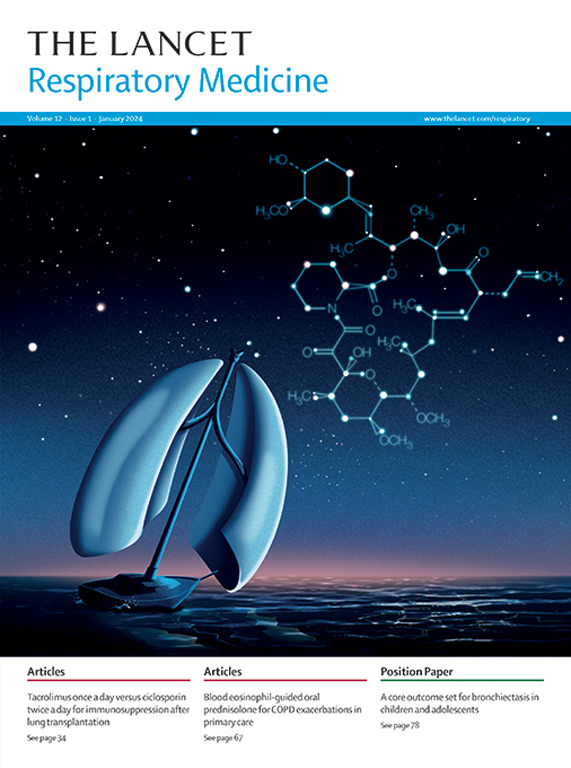初级保健中幼儿呼吸道合胞病毒感染负担:五个欧洲国家的前瞻性队列研究(2021-23)
IF 38.7
1区 医学
Q1 CRITICAL CARE MEDICINE
引用次数: 0
摘要
背景:大多数幼儿呼吸道合胞病毒(RSV)感染在初级保健中得到管理,然而,这种情况下的疾病负担仍然不明确。方法:我们在比利时、意大利、西班牙、荷兰和英国的初级保健机构进行了一项前瞻性队列研究,研究时间为2020-21年RSV季节(仅英国;从2021年1月1日起),2021 - 22日和2022-23日。向全科医生或初级保健儿科医生提出急性呼吸道感染症状的5岁以下儿童有资格进行RSV检测。RSV检测呈阳性的儿童被同意并通过医生临床报告(第1天的初次初级保健访问)和两次父母报告问卷(第14天和第30天)进行了30天的随访。在30天的随访期间,我们从临床病程(症状、病程和并发症)、医疗资源利用(初级保健就诊、急诊就诊、住院率和药物使用)和社会影响(日托或上学缺勤和父母缺勤)方面评估了RSV的负担。结果3414例患儿中,1124例(32.9%);95% CI(33.1 ~ 34.5)为RSV阳性。在有年龄资料的儿童中,RSV阳性率为38.9% (36.1 ~ 41.7;1岁以下儿童N =466 / 1198), 25.9% (24.0 - 27.9;N =513(1979)),年龄在1至5岁之间。在1124例rsv阳性儿童中,878例(78.1%)入组并收集了第1天的数据(中位年龄11.1个月[IQR 6.0 - 22.0];男孩446例(50.9%),女孩431例(49.1%)[N=877])。RSV疾病平均持续11.7天(95% CI 11.2 - 12.2;n = 794)。在第14天和第30天,804名儿童中有451名(56.1% [95% CI 52.6 - 59.6])和724名儿童中有261名(36.0%[32.6 - 39.7])报告了任何剩余症状。每个儿童的平均初级保健就诊次数为1.4次(95% CI为1.2 - 1·6;荷兰)至3.0 (2.8 - 3.3;1岁以下儿童(2·7次[2·4-2·9])高于1 ~ 5岁儿童(2·1次[1·9 - 2·2])。处方药物的使用各不相同,96名儿童中有25名(26.0% [95% CI 17.6 - 36.0];英国)至297名儿童中的228名(76.8% [71.5 - 81.5]);支气管扩张剂和抗生素是所有国家最常用的处方药。418名1 - 5岁儿童中有258名(61.7%[55.9 - 66.4])和394名1岁以下儿童中有196名(49.7%[44.7 - 58.4])报告了处方药使用情况。744例病例中,有340例(45.7%[42.1 - 49.4])因儿童呼吸道合胞病毒疾病而导致父母缺勤;平均缺勤天数从西班牙的1.3天(95% CI 0.5 - 2)到比利时的4.1天(3.5 - 5.0)不等。解释:5岁以下初级保健儿童的呼吸道合胞病毒感染与实质症状、卫生保健利用和父母缺勤有关。RSV负担在各国之间存在显著差异,可能是由于初级卫生保健系统、临床实践和寻求卫生保健行为的差异。这项研究强调了在考虑实施RSV免疫规划时考虑具体国家初级保健负担估计的重要性。资助赛诺菲和阿斯利康。本文章由计算机程序翻译,如有差异,请以英文原文为准。
Burden of RSV infections among young children in primary care: a prospective cohort study in five European countries (2021–23)
Background
The majority of respiratory syncytial virus (RSV) infections in young children are managed in primary care, however, the disease burden in this setting remains poorly defined.Methods
We did a prospective cohort study in primary care settings in Belgium, Italy, Spain, the Netherlands, and the UK during the RSV seasons of 2020–21 (UK only; from Jan 1, 2021), 2021–22, and 2022–23. Children aged younger than 5 years presenting to their general practitioner or primary care paediatrician with symptoms of an acute respiratory tract infection were eligible for RSV testing. Children who tested positive for RSV were consented and followed up for 30 days via a physician clinical report (initial primary care visit on day 1) and two parent-report questionnaires (days 14 and 30). We assessed the burden of RSV in terms of clinical course (symptoms, illness duration, and complications), health-care resource utilisation (primary care visits, emergency department visits, hospitalisation rate, and medication use), and societal impact (daycare or school absence and parental work absence) for the 30-day follow-up period.Findings
Among 3414 tested children, 1124 (32·9%; 95% CI 31·3–34·5) tested positive for RSV. Among children with data on age, RSV positivity rate was 38·9% (36·1–41·7; n=466 of 1198) in children younger than 1 year and 25·9% (24·0–27·9; n=513 of 1979) in those aged 1 to <5 years. Of the 1124 RSV-positive children, 878 (78·1%) were enrolled and had day 1 data collected (median age 11·1 months [IQR 6·0–22·0]; 446 [50·9%] boys and 431 [49·1%] girls [N=877]). RSV illness lasted a mean of 11·7 days (95% CI 11·2–12·2; n=794). At day 14 and day 30, any remaining symptoms were reported in 451 of 804 (56·1% [95% CI 52·6–59·6]) and 261 of 724 (36·0% [32·6–39·7]) children. The mean number of primary care visits per child ranged from 1·4 (95% CI 1·2–1·6; the Netherlands) to 3·0 (2·8–3·3; Spain), and was higher in children younger than 1 year (2·7 visits [2·4–2·9]) than in those aged 1 to <5 years (2·1 [1·9–2·2]). Prescribed medication use varied, from 25 of 96 children (26·0% [95% CI 17·6–36·0]; the UK) to 228 of 297 children (76·8% [71·5–81·5]; Italy), with bronchodilators and antibiotics being the most commonly prescribed medicines across all countries. Prescribed medication use was reported in 258 of 418 children aged 1 to <5 years (61·7% [56·9–66·4]) and 196 of 394 children younger than 1 year (49·7% [44·7–54·8]). Missed working days by parents due to their child's RSV illness were reported in 340 of 744 cases (45·7% [42·1–49·4]); the mean number of missed workdays ranged from 1·3 days (95% CI 0·5–2·2) in Spain to 4·1 days (3·3–5·0) in Belgium.Interpretation
RSV infections in children younger than 5 years in primary care are associated with substantial symptomatology, health-care utilisation, and parental work absence. Notable differences in RSV burden existed across countries, likely due to differences in primary health-care systems, clinical practice, and health-care-seeking behaviour. This study emphasises the importance of considering country-specific primary care burden estimates when considering the implementation of RSV immunisations programmes.Funding
Sanofi and AstraZeneca.求助全文
通过发布文献求助,成功后即可免费获取论文全文。
去求助
来源期刊

Lancet Respiratory Medicine
RESPIRATORY SYSTEM-RESPIRATORY SYSTEM
CiteScore
87.10
自引率
0.70%
发文量
572
期刊介绍:
The Lancet Respiratory Medicine is a renowned journal specializing in respiratory medicine and critical care. Our publication features original research that aims to advocate for change or shed light on clinical practices in the field. Additionally, we provide informative reviews on various topics related to respiratory medicine and critical care, ensuring a comprehensive coverage of the subject.
The journal covers a wide range of topics including but not limited to asthma, acute respiratory distress syndrome (ARDS), chronic obstructive pulmonary disease (COPD), tobacco control, intensive care medicine, lung cancer, cystic fibrosis, pneumonia, sarcoidosis, sepsis, mesothelioma, sleep medicine, thoracic and reconstructive surgery, tuberculosis, palliative medicine, influenza, pulmonary hypertension, pulmonary vascular disease, and respiratory infections. By encompassing such a broad spectrum of subjects, we strive to address the diverse needs and interests of our readership.
 求助内容:
求助内容: 应助结果提醒方式:
应助结果提醒方式:


